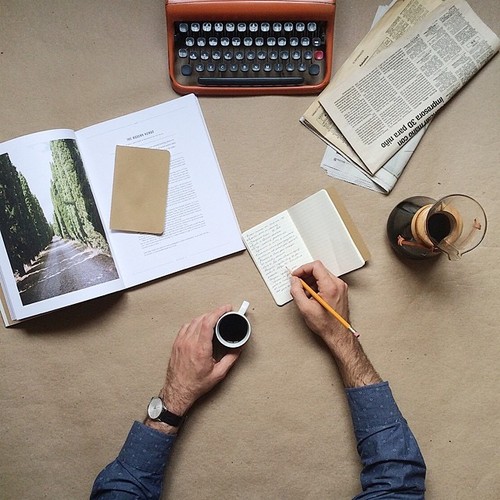Palomino announced a new line of notebooks to complement their Blackwing and Blackwing 602 pencils. The Blackwings are probably the best pencils I’ve ever used, so I have high hopes for their new notebook. Looks great.
Always Open To The Possibility Of Writing
Sometime in the early 2000’s, people stopped asking me whether or not I wrote on a computer. Before that, there was still some expectation that a writer should labor over a manual typewriter, or perhaps a legal pad, wearing pencils down to a stub. The entire act of literary creation was steeped in mystery and romance—it was voodoo, really, a kind of ritual bloodletting. Computer use was new and controversial—people wanted to know what side I came down on.
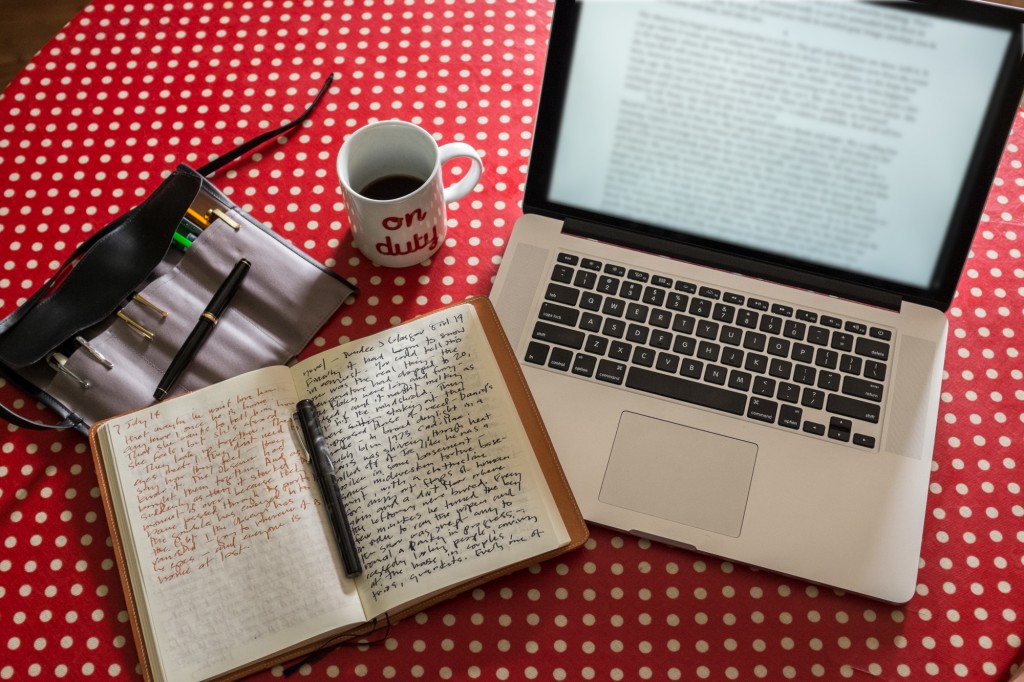
But all that changed with the rise of the laptop and the MFA program, two tools that demystified the writing process and made it available to more people. The former allowed anyone to create a literary work that, if nothing else, looked professional; the latter seemed to offer formal training and certification that turned any hack writer into something a little bit tamer and more authoritative: an “author.” Now everybody assumed you had a writing degree. Everybody assumed you were using a computer.
I came to miss those old questions, the ones that seemed to come largely from people who merely liked to read, for whom the idea of writing anything more complicated than a thank-you note might have seemed an insurmountable task. These days, most of the questions I get at readings, conferences, and the like come from people who are writers themselves, or are trying to be. How can I get into your school? Do you know anybody at The New Yorker I can send this to? Would you read something of mine? How do you get an agent? Not only have fiction and poetry writing become more egalitarian, less resistant to entry—publication has, too. If you don’t mind eschewing print (and money, of course), you can publish in any number of online journals. You can post your work on a blog or on an internet messageboard. You can self-publish your ebook. Your print book, even, for a price. Everybody’s a writer now.
Though a lot of us have wrung our hands over the death of the old-school gatekeepers, I think these changes are, broadly speaking, a good thing for the literary world. A culture more engaged with writing is one that any writer should want to be a part of. But among the things we seem to have lost is the idea that writing is a dark and unfathomable process. The irony, of course, is that it still is—it’s the same as it’s ever been. The technological ease of its production is largely illusory—our methods for making it are as arcane and diverse as ever, even if we’re all ultimately using Macbooks to push it out into the world.
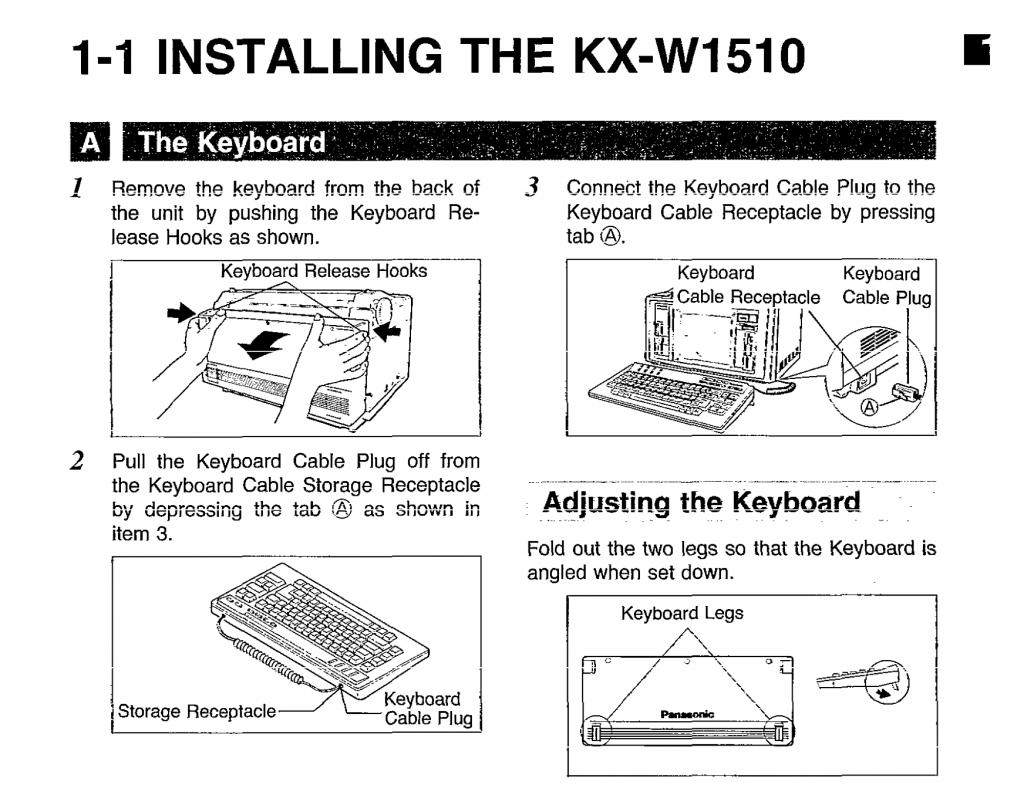
I’m a fairly technically inclined person, so I’ve always liked up-to-date writing tools. I loved my parents’ Royal upright typewriter when I was a child, and graduated to a humming Selectric (or maybe it was an Olivetti) in high school. I wrote my first abortive college novel on a glorified electric typewriter with a little LCD preview screen, and my first published novel on a standalone Panasonic word processor (I’m pretty sure it was the KX-W1510) with a built-in clackity printer that shook the pressboard buffet table it lived on. I’ve since composed with WordPerfect on a greenscreen IBM, and on the earliest Macintoshes; I wrote my novel Mailman on a Toshiba laptop as thick as a turkey club sandwich and now use good old bloated Microsoft Word, fullscreen and in “focus” view, on, yes, a Macbook Air or Pro. For the most part, my work is, or has been, tool-agnostic—the theoretical ideal is for the tech to disappear and the words to transfer from brain to page without resistance.
But lately I’ve gotten kind of throwbacky. It’s not the first time. In the early 2000’s, when the computer was taking over as the default writing tool, I tried drafting a novel with pencil and paper—it would eventually be published under the title On the Night Plain. The book takes place in the 1940’s, and I wanted to try using period tech. The second draft was typed up on an Underwood that I still own (though several generations of mice have tried living in it since, rendering it inoperable), and it wasn’t until the third that I finally transferred it all into a computer. I edited those early drafts with a red pen, at times literally cutting and pasting in the time-honored manner, with scissors and glue stick.
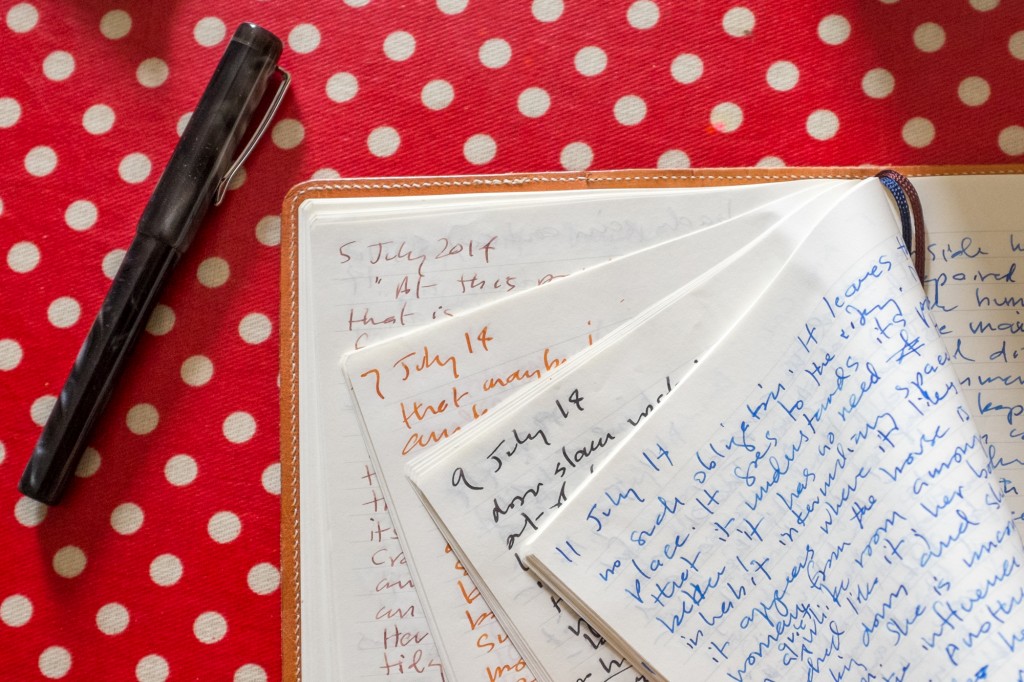
I was all digital for another decade after that, and then this past winter, vexed by professional obligations that had nothing to do with writing and that were haunting my digital life, I hauled out my old fountain pens—a couple of cheap Sheaffers, of the sort my wife and I used to use in the early nineties, and two Mont Blancs, one a college graduation present from my grandfather, the other inherited from him when he died. I had also received a Lamy Safari as a gift from a student of mine, but hadn’t got around to using it. I looked these pens up on the internet to remind myself how to put ink into them, and discovered the sprawling online world of pen, pencil, and stationery enthusiasts. The bookstore at the college where I work started stocking Rhodia pads and journals, and I started listening to the Pen Addict podcast. I also befriended some younger writers who encouraged me to join them at coffee shops for writing sessions. I hadn’t done this—working with others—for a couple of decades, and at first felt weird and exposed. But it turns out that there’s nothing that motivates quite like the sight of your friend covering pages with ink. Are you going to sit there like a loser, with your blank page? No, you are not.
My process these days varies according to what I’m writing, where it’s going to end up, and how urgent it is. I still write blog posts, student editorial memos, book reviews, and some fiction directly on the computer. But most of the short fiction I’ve written in 2014, and a lot of the novel I’ve been working on, has been drafted with a fountain pen into my favorite bound journal, the Nanami Paper Seven Seas Writer. This 480-page A5-size lined notebook is made out of the extraordinarily smooth and supple Tomoe River paper, from Japan’s Tomoegawa Co., Inc.; I keep mine tucked into a Gfeller Casemakers leather cover. I’ve now got a bunch of pens, new and old, to choose from; I particularly love the offerings from Pilot, TWSBI, Lamy, and Franklin-Christoph. I favor pens that can be filled from bottled inks—it means that every few weeks I can re-ink them with new colors. This lends a little variety to my daily life, and makes it easier to see where I left off and picked up between sessions. I switch pens for every writing session, write the date (and location, if I’m not at home) at the top of each page, and go to work. I generally write in the morning, and transfer what I’ve written to the computer in the afternoon or on the weekend, editing it on the way. (As for the digital end of my workflow—I tried a few alternate word processing programs, particularly Scrivener, which takes a skeuomorphic approach to organizing ideas. But ultimately, I’ve stuck with Word. You can customize away all the unnecessary garbage. A novel, for me, ends up as one big .doc file, no section breaks.)
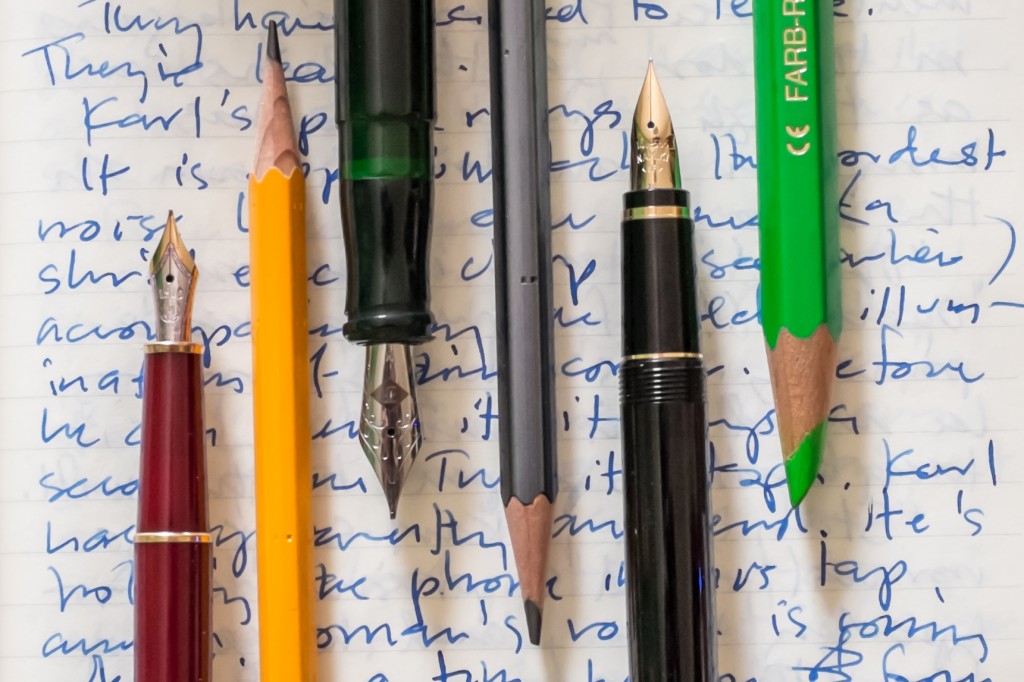
I don’t typically use the Seven Seas Writer for note-taking or list-making—for that, I’ll generally use a Field Notes. I like the ones with the newer, thicker paper—the America the Beautiful edition, or the new Shelterwood. When I’m teaching, I generally have a fresh page of an A4-size Rhodia pad in front of me (ideally a wire-bound dot grid, but I’ll use whatever the college store has in stock), clamped to an aluminum legal-size clipboard I custom-cut to fit A4; because I’m bad with names (which is another way of saying I’m lazy and inattentive), I jot down the name of anyone who speaks and make a note on what they say, in case I need to refer to it later. A student recently suggested that I write down whose hands go up and in what order, so that nobody gets left out; I do that now, too. In class I’ll use a rollerball pen, usually my Retro 51 Tornado or Karas Kustoms Retrakt, as this kind of writing is intermittent, and might cause a fountain pen nib to dry out.
Much is said about the portability of new laptops, particularly the Macbook Air. But I’m finding that I am much more likely to pull out a notebook and pen from my bag in public than I am a laptop—indeed, I’m more likely to bring them with me in the first place. If you’re never without a notebook, you’re always open to the possibility of writing. And analog tech has also freed me from the idea that I’m writing something important, official, or canonical—my crap handwriting makes me feel as though I’m just fooling around, which, ultimately, is how a lot of my best ideas are generated.
In other words, I’ve spent my entire life attempting to professionalize my passion—and now that I’ve succeeded in establishing a publishing and teaching career, I’ve backtracked, to try to make it seem like a hobby again—the way it felt in my youth, before I had a laptop or MFA. I’m still waiting for people to start asking me at readings about my favorite pens and paper—but since I’m clearly not the only writer rediscovering the pleasures of an analog workflow, it’s probably inevitable.
J. Robert Lennon is the author seven novels, including Mailman, Familiar, and Happyland, and the story collections Pieces for the Left Hand and See You in Paradise. The latter will be published by Graywolf Press in November. He teaches writing at Cornell University. He can be found on Twitter @jrobertlennon and blogs regularly at Literambivalence
The Shape of Days — Austin Kleon
The Shape of Day’s — Austin Kleon
I think our days have shapes, too — each has a beginning and an end, and we go through good and ill fortune as it progresses.
A neat idea to consider adding to your journaling process.
Writers At Work
Like it says on the tin, a Tumblr of pictures of writers at work. Oddly inspiring.
Seven Seas “Writer” Tomoe River Paper Journal (Size A5): A Review | Scribalishess
Seven Seas “Writer” Tomoe River Paper Journal (Size A5): A Review | Scribalishess
I can vouch for the Tomoe River paper. I have yet to find better. This looks like a great notebook. Might have to pick one up.
The Cramped Official T-Shirt | Teespring
The Cramped Official T-Shirt | Teespring.
Show your support for writing by hand! Get the official t-shirt of The Cramped. Your purchase helps to support the site. There are a couple of color options available and styles for both women and men. We don’t know if these will be offered again so make sure to get yours today.
Better Handwriting On Tap
by Akshata
All through school and college, somewhere in the gap between the final exam and the start of a new academic year, I forgot how to write properly. It was funny and maddening how just two months of almost writing-free vacations could make me forget what I had learned and practiced since I was in kindergarten.
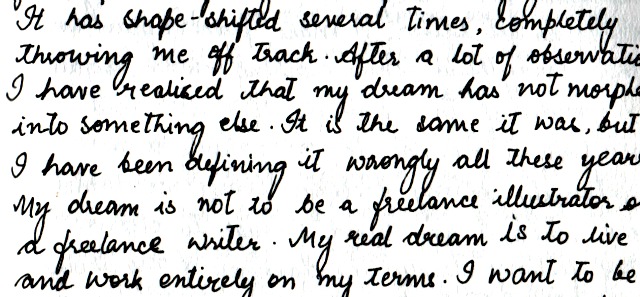
I spent the first few days of my return to class trying to rediscover the ins and outs of my handwriting, and then tearing up the crisp sheets of new notebooks that had been uglified by my attempts to do so.
After I got acquainted with the computer and began to use it on a regular basis, this handwriting-related amnesia turned into a fixture in my daily life. Every time I picked up pen and paper, I ended up frustrated that my handwriting kept changing, yet staying somewhat similar, from one snippet of writing to the next. One minute is was too sharp, the next it was too curved. One minute it was too upright, the next it was too slanted. It was my handwriting, but it wasn’t my handwriting.
It was as if a hundred students were imitating in their notebooks what their teacher had written on the blackboard. None of them got it completely wrong, but none of them got it completely right either.
I made multiple attempts to regain my natural style of writing. In the past few months, I have succeeded at it. Now my writing is fairly effortless, as it was when I was drowning in assignments in school and college. Even on the odd occasion I forget how to write properly, I get back on track with ease, simply by bringing my focus back to the mechanics of writing well. I have outlined those below to help anyone wanting to improve their penmanship, no matter how bad a state it is in right now.
Write from your upper arm, not from your wrist
When I took up a drawing class a few years ago, the instructor made me draw only circles and lines for three days straight. Concentric circles, overlapping circles, tall ovals, squishy ovals, straight lines, curved lines, zigzag lines, dark lines, light lines, wavy lines, grids, reverse lines, and every other kind that you can imagine. It was mind numbing, made more so by my impatience to get to the “real drawing”.
As I understood later, that line-and-circle exercise is what brings the fluidity to an artist’s brush or pencil strokes. It does that by ensuring that the strokes on canvas or paper arise not from the forced, constricted movement of the wrist, but from the free-flowing movement of the entire arm. Imitate this movement and you can see the difference for yourself. In the first case, only your thumb and forefinger move up and down, clutching the pen or pencil in a death grip. In the second case, the side of your palm makes smooth designs on the surface of the paper, led by the movement of your elbow, which in turn begins at your shoulder.
Replicating that arm movement can do wonders for your handwriting, but it is not easy, because you never know if you have got it right. That’s why you need the next step.
Tilt the paper
Keep your notebook angled away from you when you write. This automatically makes your elbow move outward and away from your body, which in turn relaxes your arm. Without realizing it, you loosen your hold on the pen/pencil and engage your entire arm, both of which are key to free and fluid writing.
As JD Bentley wrote in this post:
Shapes are better when they just happen, not when you try hard to make them happen.
Take your time
Write as if you have all the time in the world, and let the tip of your pen merely whisper over the surface of the paper. You’ll begin to notice that your pen strokes are becoming elongated, stylish, and curvier, all of which make for beautiful, legible handwriting. Use a fountain pen or a gel pen, and the results are even better.
If you slow down your writing at least till you have had sufficient practice at writing well, your arm internalizes that easy movement and makes you consistent at recreating it. As time elapses, it does not matter even if you write faster. The speed will not have too much of a negative impact on the aesthetics of your writing.
Memorize & Practice
Overall, my handwriting looks consistent, but when I look closely, I notice that I mix up letter styles too much. Sometimes I dot the is with a tiny speck and sometimes with a hollow circle. Either I cross the ts too high or too low. Sometimes I write capital F facing left and at other times, facing right.
I find myself pausing frequently in the midst of writing a letter, because I can’t remember how I usually write it. If this is your dilemma too, create a letter set for reference. Write each letter with care and ensure that it is closest to your ideal. Practice it till you can write it in your sleep. The accidental inconsistencies, even the minute ones, can detract from the beauty of your penmanship. The deliberate ones can add to it the charm of a signature style.
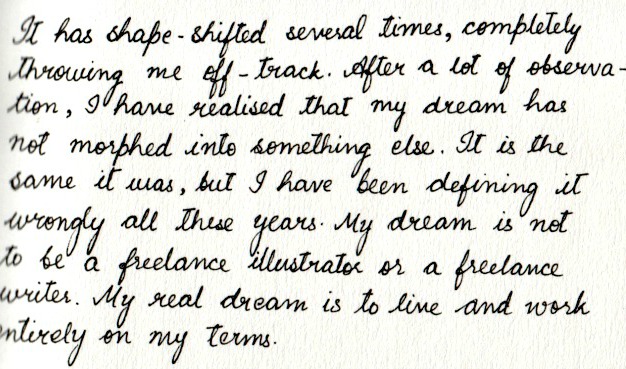
Most importantly…
Own your handwriting no matter which phase of improvement it is going through. Instead of trying to capture the elusive beauty and essence of someone else’s handwriting, focus on adding some flair to your own.
Akshata is a writer, doodler, and people watcher doing her best to find the sacred in the ordinary. In addition to writing about her slow living experiments at akshata.co, she writes for the popular technology blog MakeUseOf.
Visit to the Faber-Castell Factory
A Visit to the Faber-Castell Factory
A visit to the pencil-making factory of Faber-Castell in Stein, Germany, one of the world’s largest makers of writing instruments.
Shedworking
Shedworking is a daily updated guide for people who work in garden offices and other shedlike atmospheres.
Imagine writing every day in something like this. I know I want to.
coffee&light
Unexpected plans are always the best. — coffee&light


